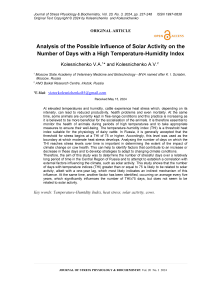Analysis of the possible influence of Solar activity on the number of days with a high temperature-humidity index
Автор: Kolesnichenko V.A., Kolesnichenko A.V.
Журнал: Журнал стресс-физиологии и биохимии @jspb
Статья в выпуске: 3 т.20, 2024 года.
Бесплатный доступ
At elevated temperatures and humidity, cattle experience heat stress which, depending on its intensity, can lead to reduced productivity, health problems and even mortality. At the same time, some animals are currently kept in free-range conditions and this practice is increasing as it is believed to be more beneficial for the socialisation of the animals. It is therefore essential to monitor the health of animals during periods of high temperatures and to take appropriate measures to ensure their well-being. The temperature-humidity index (THI) is a threshold heat index suitable for the physiology of dairy cattle. In Russia, it is generally accepted that the threshold for stress begins at a THI of 75 or higher. Accordingly, this level was used as the boundary at which moderate heat stress develops. Analysing the number of days on which the THI reaches stress levels over time is important in determining the extent of the impact of climate change on cow health. This can help to identify factors that contribute to an increase or decrease in these days and to develop strategies to adapt to changing climate conditions. Therefore, the aim of this study was to determine the number of stressful days over a relatively long period of time in the Central Region of Russia and to attempt to establish a correlation with external factors influencing the climate, such as solar activity. This study shows that the number of days with temperature indices (THI) greater than or equal to 75 is likely to be related to solar activity, albeit with a one-year lag, which most likely indicates an indirect mechanism of this influence. At the same time, another factor has been identified, occurring on average every five years, which significantly influences the number of THI≥75 days, but does not seem to be related to solar activity.
Temperature-humidity index, heat stress, solar activity, cows
Короткий адрес: https://sciup.org/143182810
IDR: 143182810
Текст научной статьи Analysis of the possible influence of Solar activity on the number of days with a high temperature-humidity index
Heat stress is a significant issue in livestock farming, particularly in cattle (West, 2003). The level of heat produced by a cow depends on various factors, such as the ambient temperature, humidity, the age of the animal, and its level of production (Barash et al. , 2001; Spiers et al. , 2004; Winton et al. , 2024). Under high temperatures and high humidity, cows experience heat stress, which can lead to decreased productivity, health issues, and even death, depending on its intensity (Spiers et al. , 2004; Vitali et al. , 2009; Winton et al. , 2024; Giannone et al. , 2023). Symptoms of heat stress can include increased respiratory and heart rates, loss of appetite, reduced milk production, and weight loss (West, 2003; Roland et al. , 2016; Müschner-Siemens et al. , 2020). To maintain the well-being and health of cows and maximize their productivity, it is essential to prevent heat stress. This can be accomplished by providing adequate water, shelter, and ventilation (Collier et al. , 1981; Spiers et al. , 2004).
However, proven methods for preventing heat stress, such as providing adequate ventilation, watering cows, and other measures (Collier et al. , 1981; Spiers et al. , 2004), are only applicable when animals are housed in barns. At the same time, some animals (Botreau et al. , 2023) currently graze freely, and this trend is increasing, as it is believed to be more beneficial for animal welfare due to increased socialization (Wormsbecher et al. , 2017; Broucek et al. , 2008). In addition, not only dairy cows are free-ranging on farms (Botreau et al. , 2023; Gantner et al. , 2011), but some other animals (particularly calves) are also kept in barns on farms where dairy cattle are housed (Broucek et al. , 2008; Wormsbecher et al. , 2017).
When animals go out to graze during hot weather, they may be exposed to stressful, high-temperature environmental conditions (Villalba & Manteca, 2019). High outside temperatures can lead to decreased animal performance, increased water and nutrition requirements, and increased risk of disease in much the same way as high temperatures inside the barn (Broucek et al., 2008; Wormsbecher et al., 2017). In addition, animals may experience discomfort and stress due to heat, which can negatively impact their health and well-being (Broucek et al., 2008; et al., 2023). Therefore, it is important to monitor the condition of animals during periods of high temperatures and take measures to ensure their comfortable existence.
The temperature-humidity index (THI) is a heat index threshold suited to dairy cattle physiology. It takes into account the combined effects of ambient temperature and relative humidity and is a useful and simple way to assess the risk of heat stress. Dairy cows are known to be vulnerable to heat stress. Productivity declines when: 1) A severe thermal stress event occurs; 2) An extended thermal stress event occurs.
There are thresholds above which different degrees of stress occur (Roland et al. , 2016; Gantner et al. , 2011; Yan et al. , 2021); therefore profit risk is linked to the frequency of exceeding stress thresholds.
The initial studies conducted in the 1950s at the University of Missouri indicated a stress threshold of a 71 THI, so animals were experiencing heat stress at a THI of 72 and greater (Gantner et al. , 2011; Yan et al. , 2021). The levels of stress were separated into: 1) Mild (72 to 79 THI); 2) Moderate (80 to 89 THI); Severe (90 THI or greater).
Today’s high-yielding dairy cows are much more susceptible to heat stress than the cows of the 1950s due to the increased milk production and feed intake. The recent studies show that modern cows become heat-stressed starting at an average THI of 68 with the levels of stress increase with increasing THI values (Vitali et al. , 2009; Collier et al. , 2011; Gantner et al. , 2011; Pinto et al. , 2020). When the THI exceeds 72, cows are likely to begin to experience heat stress and this will affect their calves. When the THI exceeds 78, cow’s milk production is seriously affected. When the THI rises above 82, very significant losses in milk production is happening, cows show signs of severe stress and may ultimately die.
Due to the fact that in Russia, cross-breeds of Holstein cattle are bred with local hardy breeds and the level of crossbreeding is not high, it has been accepted that the threshold for stress begins at a THI value of 75 or higher (Wtoriy et al., 2016). Therefore, the chosen boundary value for the study was THE = 75 at which moderate heat stress was considered to have developed.
Analyzing the number of days that the THI (a measure of cow stress) reached high levels by year is essential to assess the magnitude of the impact of climate change on cow health. This analysis can help identify factors that contribute to the increase or decrease in the frequency of such events and develop strategies to adapt to changing climate conditions.
It is known that one of the factors influencing climate at the level of the entire planet is solar activity (De Jager, 2008). There are still many questions about how exactly the Sun influences climate, but it can be assumed that direct solar energy is not the most important factor, but rather indirectly affects atmospheric circulation. However, a close correlation between solar activity and climate has been established.
Thus, the purpose of the work was to determine the number of days with stressful conditions over a certain fairly long period for the region of central Russia and to try to establish a connection with external influences on climate, such as solar activity.
MATERIALS AND METHODS
Weather conditions analysis sites.
The following weather stations were selected for analysis: Uglich, Nemchinovka, Voronezh, Shakhunya, which are located approximately in the direction from south to north and are located near the centres of dairy farming.
-
1) Location of the Voronezh weather station (Voronezh region, Russia): latitude 51.70 longitude 39.21 altitude 149 m.
-
2) Location of the Nemchinovka weather station (Moscow, Russia): latitude 55.70 longitude 37.37 altitude 197 m.
-
3) Location of the Uglich weather station (Yaroslavl region, Russia): latitude 57.50 longitude 38.30 altitude 122 m.
-
4) Location of the Shakhunya weather station (Nizhny Novgorod region, Russia): latitude 57.66 longitude 46.63 altitude 175 m.
Weather data for the summer months of the 20112023 periods from selected weather stations were obtained from the website
Temperature-Humidity Index calculation
The THI index was calculated using the formula (Thom, 1959):
THI = T+0,36*Tp+41,2 (1)
Where:
Т - dry-bulb temperature
Тр - wet-bulb temperature (Thom, 1959)
The number of days when the index value exceeded the stress level was calculated as follows. For each value of T and Tp recorded by the weather station every 3 hours, the THI index was calculated and plotted on the graph. Further, if the THI index was equal to or greater than 75 (Figure 1), then this day was considered stressful and was taken into account in the number of stressful days in the month.
Calculation of solar activity
Statistical analyses
The data obtained were subjected to Regression analysis using LibreOffice Calc program.
RESULTS AND DISCUSSION
THI index calculation and estimation the sum of days with stressful conditions
Based on dry-bulb and wet-bulb temperature data obtained from weather stations, the number of days with stressful conditions for the warm months of 2011-2023 was calculated, which were entered into Table 1 on a monthly basis. As can be seen from the data in Table 1 and Figures 2 and 3, the distribution of days with stress conditions differed quite strongly among the analyzed warm months (May, June, July, August, September) (Figure 2).
Figure 2 shows that for more northern regions (Uglich, Nemchinovka, Shakhunya) the sums of the number of days with stressful conditions for all analyzed years are quite close and have a maximum number of days with stressful conditions in July. For the northernmost regions (Uglich, Shakhunya), the number of such days in June exceeds (Uglich) or is approximately equal to (Shakhunya) the number of days in August. In more southern regions, the number of days with stressful conditions in August increases and becomes greater than in June (Nemchinovka), closely approaching the number of such days in August (Voronezh).
Analysing the data in Table 1 by year (Figure 3), one can see that the number of such days has fairly well-defined peaks in 2011, 2016 and 2021. At the same time, an attempt to construct a linear regression (Figure 4) shows extremely weak trends both towards a decrease (Figure 4 B, D) and an increase (Figure 4 A, C) with an extremely low value of the coefficient of determination R2.
Calculation of solar activity for analysis
In order to ascertain whether solar activity is correlated with the number of days with stressful conditions, it was assumed that solar activity in a given month directly and immediately affects the number of days with stressful conditions. In this regard, a graph of average solar activity values was constructed for the following warm months: May, June, July, August, September (Figure 5). As can be seen from Figure 5, the solar activity graphs for these five studied months were quite similar. Some differences between the months were noted in the period from 2011 to 2017. However, after 2018, the graphs were practically merged.
The regression calculated for these graphs showed that the coefficients of determination R2 in the May– August range were greater than 0.9, and only September had a slightly lower regression coefficient with the other months, but it was also high.
Given the close proximity of the coefficients, it was deemed appropriate to utilise the mean value between these months (May, June, July, August, September) for each year. This represented graphically in Figure 6. These mean values were subsequently employed in subsequent analyses.
Analysis of the solar activity contribution to the number of days exceeding the THI Index for each year
First of all, it was necessary to test the hypothesis about the possibility of a direct influence of solar activity on the number of days with THI≥75 in the same year. Regression analysis showed that in this case there is no correlation between these values (Figure 7). Indeed, the value of the R2 coefficient between these data series in the case of all four weather stations was about 0.007 and less. Thus, the hypothesis that solar activity affects the number of days with THI≥75 in the same year was not confirmed.
However, the curves of changes in the number of days with THI≥75 by year (Figure 3) and the curve of the level of solar activity (Figure 6) had some visual similarity, so it was hypothesized that solar activity may affect the change in the number of days with THI≥75 not in the same year but in the next. For that purpose, regression analyses were performed between data on changes in solar activity and the number of days with THI≥75 in the following year.
Indeed, in this case, the value of the coefficient R2 between these data series in the case of all four weather stations was much greater – in the case of Voronezh it was 0.15, in the case of Shakhunya it was 0.28, in the case of Uglich it was 0.32, and in in the case of Nemchinovka it was 0.40. Thus, the impact of changes in solar activity on the number of days with THI≥75 in the next year for these weather stations ranged from 15 to 40%.
It is interesting to note that for the data averaged between these weather stations (Figure 9A), the R2 coefficient between these data series was even higher at 0.41 (Figure 9B).
However, in Figure 9B, one can see some periodic peaks, appearing on the graph every 5 years that are the influence of some other periodically acting factor. The years of influence of this factor are marked in Figure 9A with red arrows. To try to eliminate its impact on the average number of days with THI≥75 by year, for those years when it has impacted, the average values between the number of days in the previous and subsequent years were calculated (for the point in 2011 – the trend value for the two subsequent years) (Figure 9C) and was performed a regression analysis of the resulting data series of corrected average number of days with THI≥75 by year and the solar activity (Figure 9D). The results of the analysis show that when these peaks are excluded from the analysis, the R2 coefficient increases to 0.87, which suggests that in the period 2011–2023, up to 87% of the number of days with THI≥75 depends on changes in solar activity.
It is also interesting to note that when trying to analyze the behavior of this trait eliminated in Figure 9C, when its effect, calculated as the difference between the values of the corresponding points in the graph from Figure 9A and the graph from Figure 9C, it was displayed in Figure 9E, a regression with the ordinal year of observation was linear, and the coefficient R2 was 0.98. Moreover, the difference between the values of the corresponding points of the graph from Figure 9A and the graph from Figure 9C was 6.25 days in 2011, 8.63 days in 2017 and 10.13 days in 2022, that is, each subsequent exposure to this factor increased the number of days with THI≥75 by about 2 days.
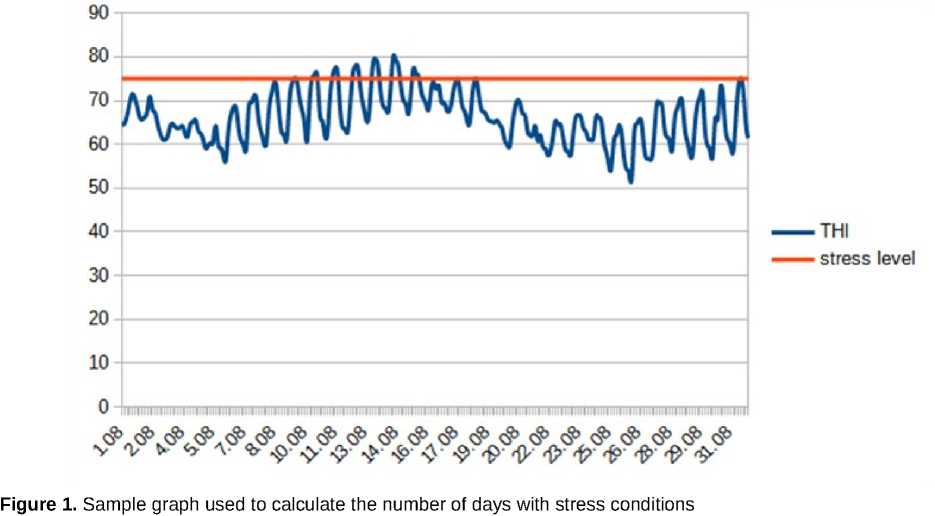
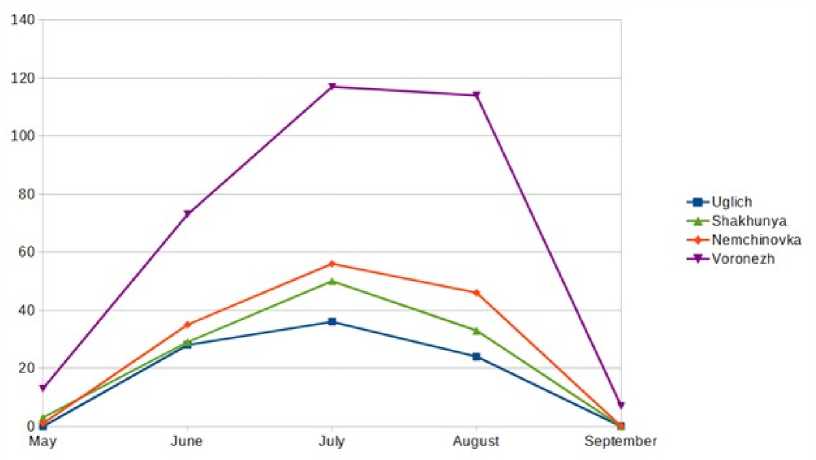
Figure 2. Sum of days with stressful conditions (THI≥75) during the warm months of 2011-2023 per month
|
S о |
со |
со |
5 |
’t а |
з 5 |
со |
О) см |
о ш |
со со |
о |
t 3 |
о |
00 см |
со со |
см |
о |
2 3 |
in со |
СО 1П |
СО |
о |
||||||||||||||||||||
|
л N 3 XJ |
о |
о |
in |
Я |
о |
ю |
с с |
0 м з XI |
о |
о |
со |
о |
со см о см |
о |
о |
о |
о |
0 м 3 м |
о |
о |
см |
о |
о |
||||||||||||||||||
|
XI XI Э XI |
о |
ш |
о |
2 |
о |
00 (XJ |
см см о см |
о |
о |
00 |
00 |
о |
со |
см см о см |
о |
см |
со |
in |
о |
о |
м м 3 м |
о |
со |
о |
о |
о |
см |
||||||||||||||
|
XI э XI |
о |
00 гЧ |
CXI |
о |
со |
см о см |
о |
о |
тГ |
о |
о |
гЧ |
см о см |
о |
О) |
00 |
см |
о |
2 |
с |
м 3 м |
о |
о |
2 |
ш |
о |
со см |
||||||||||||||
|
э XI 3 XI |
о |
00 |
00 |
со |
CXJ |
см |
с |
3 м м |
о |
о |
(О |
о |
о |
СО |
о см о см |
о |
см |
о |
о |
со |
3 м 3 м |
о |
СО |
со |
см |
о |
а |
||||||||||||||
|
□ XI |
CXJ |
я |
о |
00 |
з м |
о |
см |
о |
о |
о |
см |
с с с |
3 м |
о |
со |
о |
о |
о |
со |
3 м |
о |
со |
о |
о |
|||||||||||||||||
|
о з XI |
о |
со |
00 |
со |
см |
0 з м |
о |
со |
in |
о |
О) |
с с с |
0 3 XI |
о |
см |
о |
о |
со |
0 3 м |
о |
см |
со |
о |
о |
ш |
||||||||||||||||
|
3 Х| |
о |
in |
СХ| |
СХ| |
о см |
□ м |
о |
о |
см |
о |
со |
с с |
3 м |
о |
о |
со |
о |
3 м |
о |
о |
о |
см |
|||||||||||||||||||
|
00 CM ° |
О □ XJ |
00 |
со |
о |
со со |
0 з м |
о |
см |
о |
о |
Й |
(J с с |
0 3 м |
о |
«Н |
со |
^ |
о |
00 |
0 3 м |
о |
со |
о |
||||||||||||||||||
|
CXI о (Л £ с |
П □ XI |
00 |
хг |
о |
хг см |
п 3 м |
со |
со |
о |
о |
о |
и с с |
0 3 м |
о |
о |
о |
о |
о |
о |
п 3 м |
о |
о |
о |
см |
о |
см |
|||||||||||||||
|
о Е Е я 5 |
t 3 Х| |
ID |
со |
00 |
я |
о |
см |
3 м |
о |
о |
см |
о |
со |
о см |
о |
см |
со |
см |
о |
3 м |
о |
о |
со |
СО |
о |
о |
|||||||||||||||
|
ф £ О) с э |
■о з XJ |
со |
00 |
со |
СО |
о |
о см |
с |
0 3 м |
о |
(О |
со |
о |
о |
с с с |
0 3 м |
о |
СО |
о |
о |
о |
СО |
0 3 м |
СО |
см |
со |
о |
см |
|||||||||||||
|
сл с р |
XI з XI |
о |
о |
СХ| |
о |
о |
о со |
см о см |
о |
о |
со |
о |
с с с |
XI 3 XI |
о |
о |
см |
см |
о |
’t |
м 3 |
о |
о |
о |
см |
||||||||||||||||
|
о и 0) ф |
з XJ |
CXJ |
ш |
00 |
о |
(О см |
м |
о |
о |
00 |
in |
о |
со |
с с |
3 |
о |
см |
со |
см |
о |
1 3 |
о |
со |
н |
Xt |
о |
3 |
||||||||||||||
|
СП g (/) 5 •о о |
« S |
ф с о |
3 |
со СП < |
ф п Е а а ф со |
я 2 |
£ S |
ф с 0 |
0 |
У) 0 б) 0 < |
ф о Е о. ф (Л |
2 S |
$ 2 |
ф с 0 |
> 0 |
сл 0 0 < |
ф -Q Е о. ф (Л |
2 О |
>> л S |
ф 0 |
0 |
сл 0 0 < |
ф -О Е 2 Q- ф сл |
2 2 |
|||||||||||||||||
|
ф п Е 3 Z Ф .Q |
С N Ф С 3 5 |
л с 0 -С со |
-С р D |
1 о с о Е ф Z |
|||||||||||||||||||||||||||||||||||||
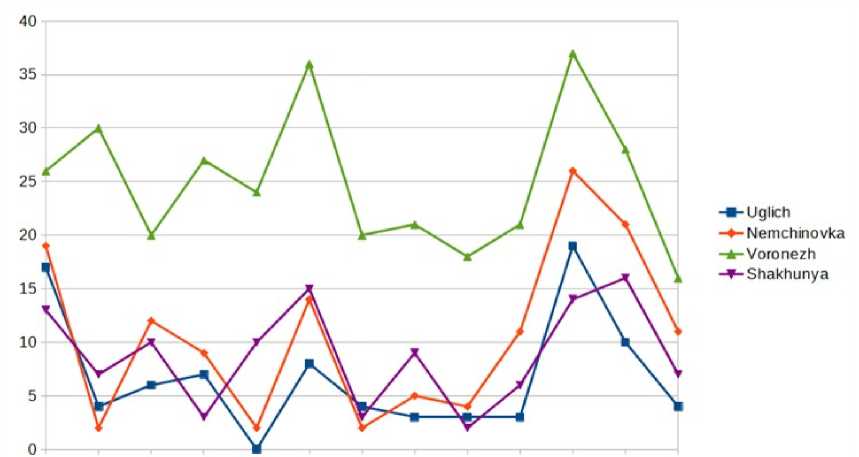
2011 2012 2013 2014 2015 2016 2017 2018 2019 2020 2021 2022 2023
Figure 3. Sum of days with stressful conditions (THI≥75) during the warm months of 2011-2023 per years
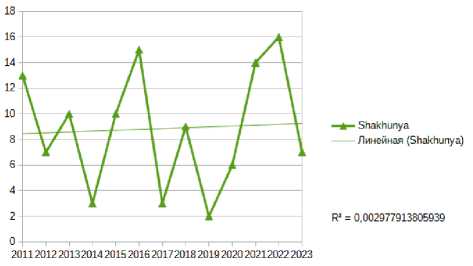
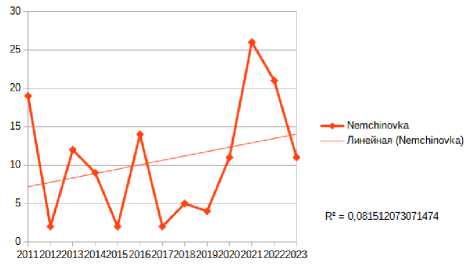
A
C
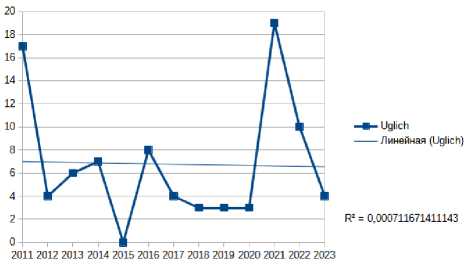
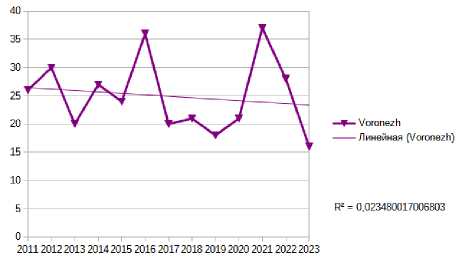
B
D
Figure 4. Graphs of the sum of days with stressful conditions (THI≥75) by year and linear regression for them. A -Shakhunya, B - Uglich, C - Nemchinovka, D - Voronezh
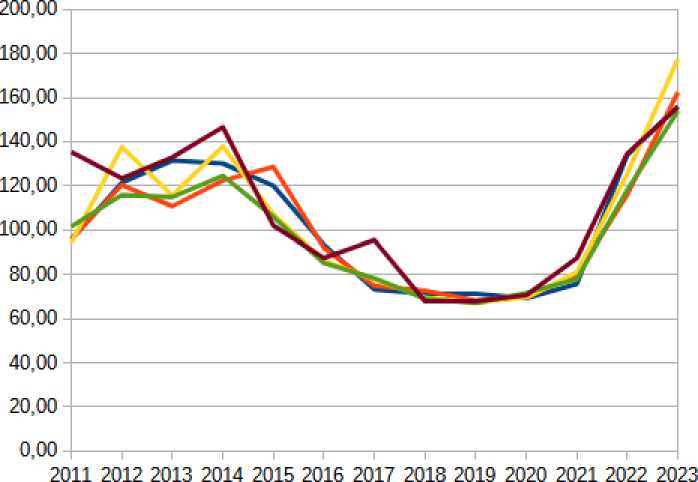
May
June
July August September
Figure 5. Graphs of average solar activity values for the following warm months: May, June, July, August, September in 2011 - 2023.
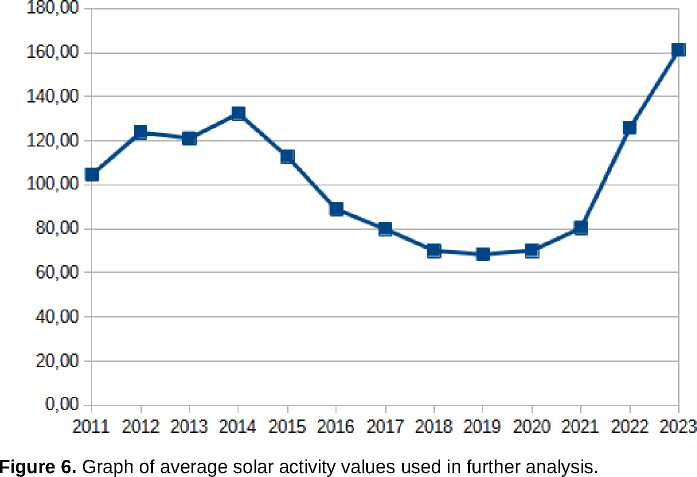
■ average May-September
Table 2. Matrix of regression coefficients when analyzing solar activity by month
|
May |
June |
July |
August |
September |
|
|
May |
1,00 |
0,92 |
0,91 |
0,95 |
0,79 |
|
June |
1,00 |
0,92 |
0,93 |
0,70 |
|
|
July |
1,00 |
0,96 |
0,79 |
||
|
August |
1,00 |
0,88 |
|||
|
September |
1,00 |
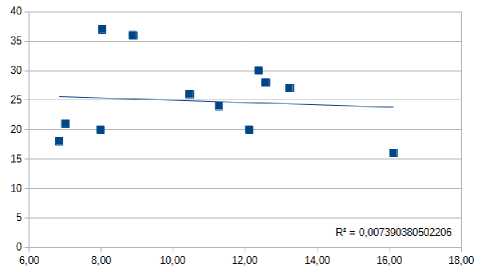

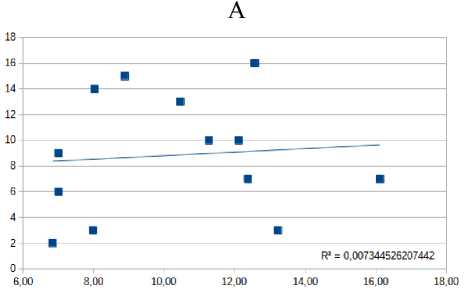
C
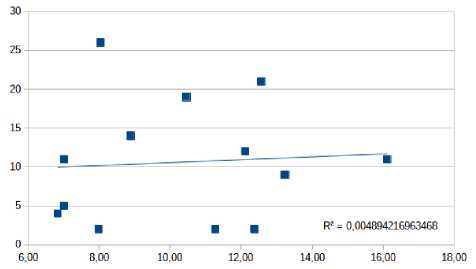
BD
Figure 7. Regression analysis of the level of solar activity and the number of days per year with THI≥75, assuming the possibility of a direct influence of solar activity on the number of days with THI≥75 in the same year. A -Voronezh, B - Shakhunya, C - Uglich, D - Nemchinovka
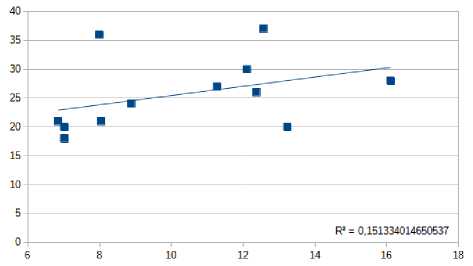
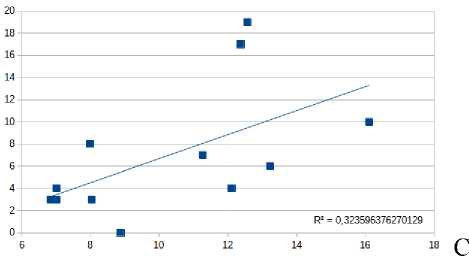
A
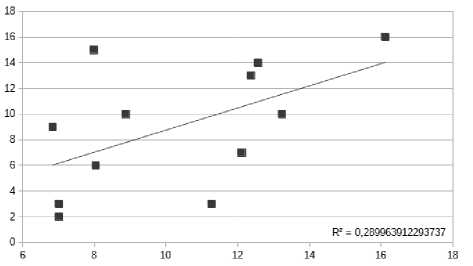
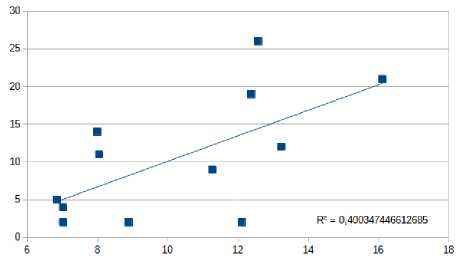
BD
Figure 8. Regression analysis of the level of solar activity and the number of days per year with THI≥75, assuming the influence of solar activity on the number of days with THI≥75 with a delay of a year. A - Voronezh, B -Shakhunya, C - Uglich, D - Nemchinovka
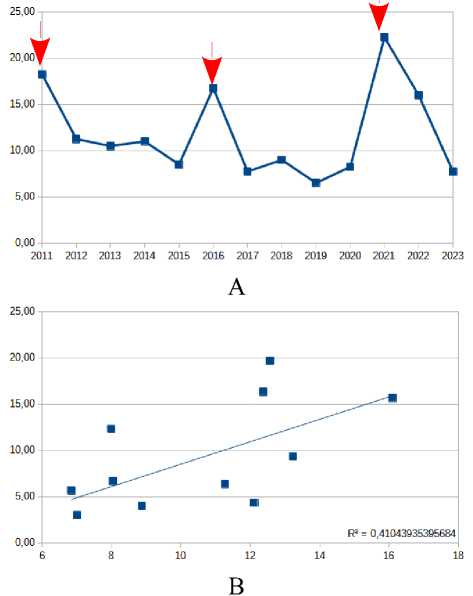
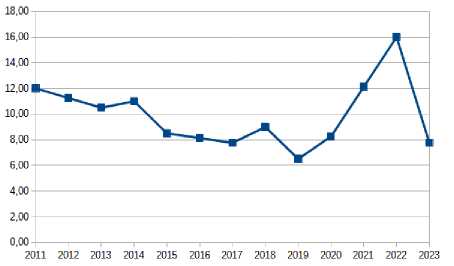
C

Figure 9. Average number of days with THI≥75 by year for all weather stations and regression analysis of the level of solar activity and the number of days per year with THI≥75, assuming the possibility of a delay in the influence of solar activity on the number of days with THI≥75 per year and an attempt to exclude the influence of the factor with periodicity in drinking years.
A – average number of days with THI≥75 by year for all weather stations;
B – regression between option A and the level of solar activity;
C – average number of days with THI≥75 by year for all weather stations after excluding the peaks with a periodicity of 5 years;
D - regression between option C and the level of solar activity;
E – regression for values with the observation year number excluded from the analysis in Figure C.
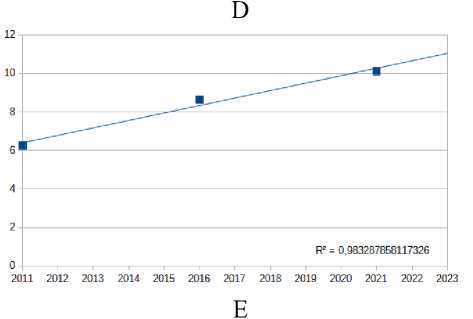
The relationship between the level of solar activity and weather has been studied for quite a long time (Laut, 2003; Mokhov practically not studied. At the same time, the importance of studying them in order to be able to predict, even with a fairly low degree of probability, the number of days with THI≥75 at least a year in advance, will allow us to prepare means to protect animals from stress.
CONCLUSION
This work shows that the number of days with THI≥75 is very likely associated with solar activity, but occurs with a delay of one year, which most likely indicates an indirect mechanism for this influence process. Unfortunately, the available weather data corresponds to only one cycle of solar activity, which does not allow us to speak about the results obtained with a sufficient degree of confidence, but for this cycle of solar activity, regression analysis of the level of solar activity and the number of days per year with THI≥75 shows a fairly high level cause-and-effect relationship between these phenomena with a lag of one year. At the same time, another factor was identified that quite strongly influences the number of days with THI≥75 every five years, but, at the same time, apparently has nothing to do with solar activity.
CONFLICTS OF INTEREST
The authors declare that they have no potential conflicts of interest.
Список литературы Analysis of the possible influence of Solar activity on the number of days with a high temperature-humidity index
- Barash, H., Silanikove, N., Shamay, A., & Ezra, E. (2001). Interrelationships among ambient temperature, day length, and milk yield in dairy cows under a Mediterranean climate. Journal of Dairy Science, 84(10), 2314-2320.
- Botreau, R., Lesimple, C., Brunet, V., & Veissier, I. (2023). Review - Environmental enrichment in ruminants and equines - Introduction. EURCAW Ruminants & Equines. https://doi.org/10.5281/zenodo.7685132
- Broucek, J., Kisac, P., Uhrincat, M., Hanus, A., & Benc, F. (2008). Effect of high temperature on growth performance of calves maintained in outdoor hutches. Journal of Animal and Feed Sciences, 17(2), 139.
- Collier, R. J., Eley, R. M., Sharma, A. K., Pereira, R. M., & Buffington, D. E. (1981). Shade management in subtropical environment for milk yield and composition in Holstein and Jersey cows. Journal of Dairy Science, 64(5), 844-849.
- Collier, R. J., Zimbelman, R. B., Rhoads, R. P., Rhoads, M. L., & Baumgard, L. H. (2011). A re-evaluation of the impact of temperature humidity index (THI) and black globe humidity index (BGHI) on milk production in high producing dairy cows. In Western Dairy Management Conf. Reno, NV. USA (pp. 113-125).
- Connolly, R., Soon, W., Connolly, M., Baliunas, S., Berglund, J., Butler, C. J.....& Zhang, W. (2021). How much has the Sun influenced Northern Hemisphere temperature trends? An ongoing debate. Research in Astronomy and Astrophysics, 21(6), 131.
- De Jager, C. (2008). Solar activity and its influence on climate. Netherlands Journal of Geosciences, 87(3), 207-213.
- Gantner, V., Mijic, P., Jovanovac, S., Raguz, N., Bobic, T., & Kuterovac, K. (2011). Influence of temperature-humidity index (THI) on daily production of dairy cows in Mediterranean region in Croatia. In Animal farming and environmental interactions in the Mediterranean region (pp. 7178). Wageningen Academic.
- Gantner, V., Mijic, P., Kuterovac, K., Solic, D., & Gantner, R. (2011). Temperature-humidity index values and their significance on the daily production of dairy cattle. Mljekarstvo: casopis za unaprjeóenje proizvodnje i prerade mlijeka, 61(1), 56-63.
- Giannone, C.; Bovo, M.; Ceccarelli, M.; Torreggiani, D.; Tassinari, P. (2023) Review of the Heat Stress-Induced Responses in Dairy Cattle. Animals, 13, 3451. https://doi.org/10.3390/ani13223451
- Laut, P. (2003). Solar activity and terrestrial climate: an analysis of some purported correlations. Journal of Atmospheric and Solar-Terrestrial Physics, 65(7), 801-812.
- Mufti, S., & Shah, G. N. (2011). Solar-geomagnetic activity influence on Earth's climate. Journal of Atmospheric and Solar-Terrestrial Physics, 73(13), 1607-1615.
- Muschner-Siemens, T., Hoffmann, G., Ammon, C., & Amon, T. (2020). Daily rumination time of lactating dairy cows under heat stress conditions. Journal of Thermal Biology, 88, 102484
- Nicolet, M., & Bossy, L. (1985). Solar radio fluxes as indices of solar activity. Planetary and space science, 33(5), 507-555.
- Pinto, S., Hoffmann, G., Ammon, C., & Amon, T. (2020). Critical THI thresholds based on the physiological parameters of lactating dairy cows. Journal of Thermal Biology, 88, 102523.
- Roland, L., Drillich, M., Klein-Jobstl, D., & Iwersen, M. (2016). Invited review: Influence of climatic conditions on the development, performance, and health of calves. Journal of dairy science, 99(4), 2438-2452.
- Spiers, D. E., Spain, J. N., Sampson, J. D., & Rhoads, R. P. (2004). Use of physiological parameters to predict milk yield and feed intake in heat-stressed dairy cows. Journal of Thermal Biology, 29(7-8), 759-764.
- Stauning, P. (2011). Solar activity-climate relations: A different approach. Journal of Atmospheric and Solar-Terrestrial Physics, 73(13), 1999-2012.
- Thom, E.C. (1959) The discomfort index. Weatherwise, v.12, p.57-59.
- Villalba, J. J., & Manteca, X. (2019). A Case for Eustress in Grazing Animals. Frontiers in veterinary science, 6, 303. https://doi.org/10.3389/fvets.2019.00303
- Vitali, A., Segnalini, M., Bertocchi, L., Bernabucci, U., Nardone, A., & Lacetera, N. (2009). Seasonal pattern of mortality and relationships between mortality and temperature-humidity index in dairy cows. Journal of dairy science, 92(8), 3781-3790. https://doi.org/10.3168/jds.2009-2127
- West, J. W. (2003). Effects of heat-stress on production in dairy cattle. Journal of dairy science, 86(6), 2131-2144.
- Winton, T.S.; Nicodemus, M.C.; Harvey, K.M. (2024) Stressors Inherent to Beef Cattle Management in the United States of America and the Resulting Impacts on Production Sustainability: A Review. Ruminants, 4, 227-240. https://doi.org/10.3390/ruminants4020016
- Wormsbecher, L., Bergeron, R., Haley, D., De Passille, A. M., Rushen, J., & Vasseur, E. (2017). A method of outdoor housing dairy calves in pairs using individual calf hutches. Journal of Dairy Science, 100(9), 7493-7506.
- Wtory V.F., Gordeev V.V., Wtory S.V., Lantsova E.O. (2016) The cowshed's temperature -and- humidity conditions with graphic information modeling using assessment. Journal of VNIIMZH, №4(24), 67-72.
- Yan, G., Liu, K., Hao, Z., Shi, Z., & Li, H. (2021). The effects of cow-related factors on rectal temperature, respiration rate, and temperature-humidity index thresholds for lactating cows exposed to heat stress. Journal of Thermal Biology, 100, 103041.
- Zherebtsov, G. A., Kovalenko, V. A., Molodykh, S. I., & Kirichenko, K. E. (2013). Influence of solar activity on the temperature of the troposphere and ocean surface. Bul. Irkutsk State University. Ser. Earth Sciences, 6(1), 61-79.
- Zherebtsov, G. A., Kovalenko, V. A., Molodykh, S. I., & Rubtsova, O. A. (2011). The regularities of climate changes in XX century and main physical processes, responsible for these changes. The bulletin of Irkutsk State University. «Geoarchaeology, Ethnology, and Anthropology Series», (1), 87-108.

